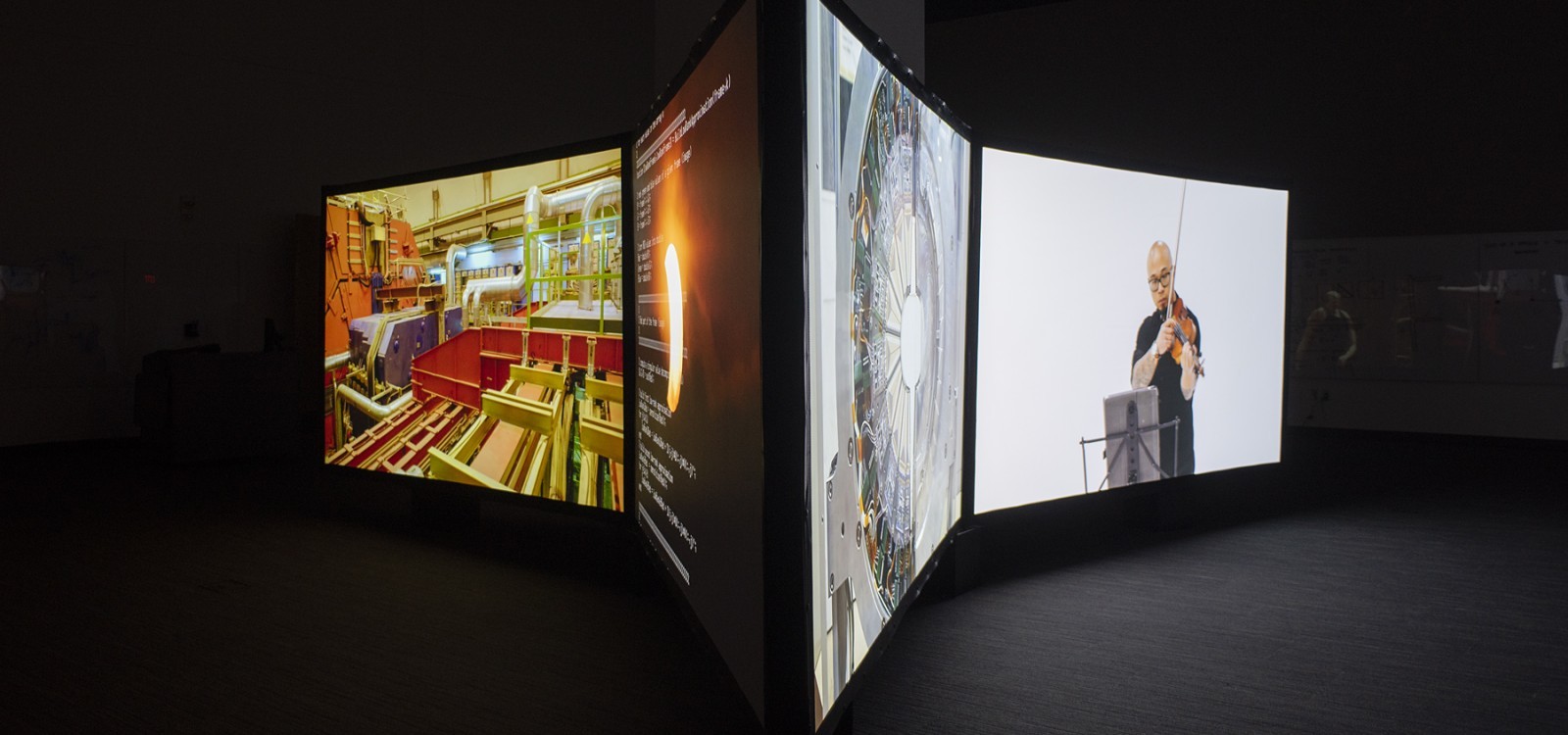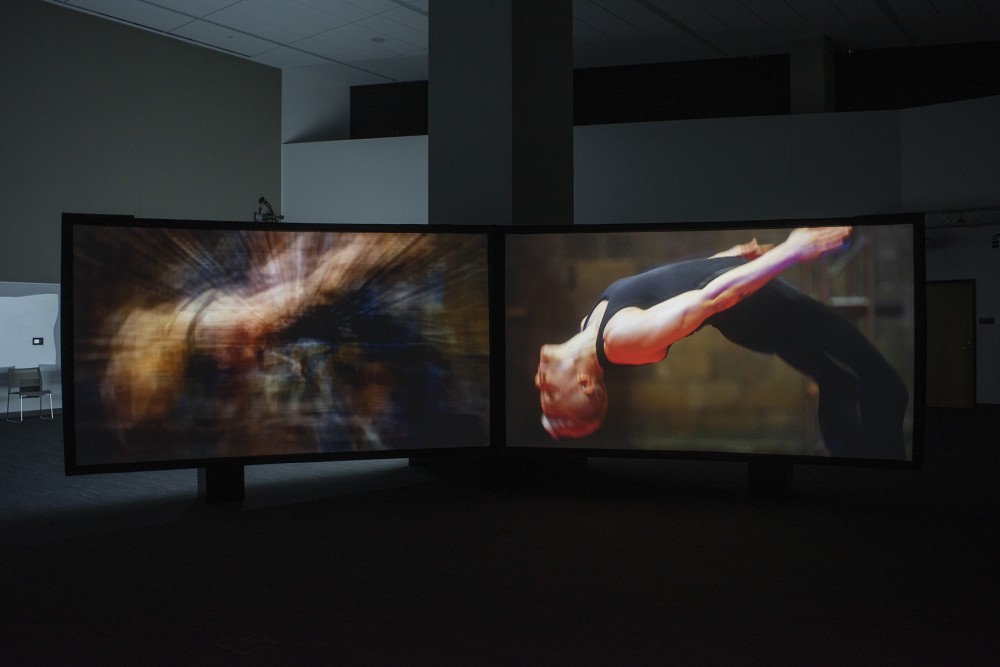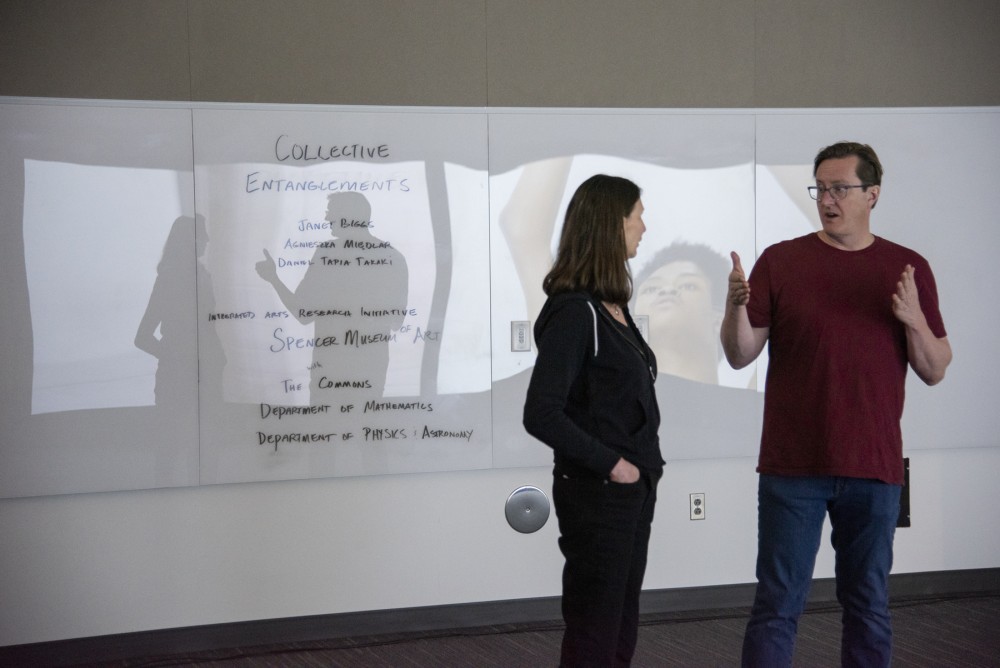
Cross-culture collaboration at CERN and the Spencer Museum
After their recent stay at CERN, we spoke to artist Janet Biggs, CERN physicist Daniel Tapia, mathematician Agnieszka Międlar and curator Joey Orr about the process of their two-year collaborative research, the use of mathematical tools for the production of performance, and how this interdisciplinary work is impacting their practices
How did the collaborative research come about?
Daniel Tapia Takaki’s involvement with the Spencer Museum of Art goes back to at least 2014, when he was involved in organizing a panel discussion at KU around artists and scientists that included representatives from CERN. After several years of being in conversation with the Museum, he and Agnieszka Międlar became Arts Research Integration faculty research fellows for the Museum in 2021. At this point, they had already been collaborating with artist Janet Biggs for over a year.
One of the questions of your research project is using time-based media to explore questions in high-energy physics. Can you tell us more about the specific questions you are researching and what methodologies you use to involve time-based media?
In the beginning, we were thinking about how to understand phenomena that occur in an initial state before the collisions that are recorded in the LHC or even in the case of near misses. At first, we conceived of the initial state as chronologically before existing data, so a time-based medium seemed particularly useful in this regard. What we learned through the process, however, was that “initial state” may not only refer to a chronologically prior state but might also contain information that is in some way fundamental to the entire phenomenon. In analogy to the initial state of protons before they collide, might there also be an initial state in video, something fundamental to the entire video across all frames?

Collective Entanglements at the Spencer Museum of Art, 2022
In the other strand of your project, you research how to apply novel mathematical techniques to the production of video and performance, which has resulted in the performance Singular Value Decomposition and the six-channel sound and video installation Entanglements. Can you tell us more about the research process of these works and the collaboration with other musicians and dancers?
Early in the work, we turned to mathematical tools used to build pictures of non-colliding particles not captured by the LHC, such as the singular value decomposition. In the performance, Singular Value Decomposition, the collaborators shifted SVD from a strictly mathematical approach into the time-based, performative contexts of choreography and composition. They asked these artists to reduce the rank of their respective dance and music pieces to an “optimal dimension”—removing as much redundant information as possible without destroying the integrity of the works. When, for example, missing music eradicated important markers for the dance, there were opportunities to explore entanglement outside the strict contexts of science.
The six-channel sound and video installation raised many more questions. Applying techniques for tensor-trains in one part of the work, the collaborators used a higher-order SVD on the video to obtain a radically different effect. Although the SVD effectively introduced data as a material and a formal element of the artwork itself, the added dimensions in this part of the installation addressed channel and time. This not only had a thickening effect on the image but also raised important questions about phenomena the collaborators knew to be there. However, it was no longer visually represented.
Janet, you have extensively navigated the crossovers between art, science and technology in your work. Can you tell us more about your long-term engagement with particle physics and your recent stay at CERN?
Janet Biggs: I first visited CERN in 2017 and was able to film inside the CMS cavern during an upgrade to the experiment. Exposure to the incredible scale of the physical technology and the generosity of the physics and engineering communities was inspiring, but ultimately the experience was overwhelming. Trying to create a piece using the footage I gathered became impossible. Any access points I could imagine felt inadequate. Try as I might, I was unable to produce a piece and finally shelved the footage. In 2020, I was invited to become part of the Spencer Museum’s Arts Research Integration program in collaboration with Arts at CERN. I pulled out my footage from 2017 as a reminder that collaborative conversations, questions, and shared research needed to drive the project, not my video imagery.
‘Applying novel mathematical techniques used in quantum mechanics to produce video and performance works, we considered our pieces experiments’
I often collaborate with scientists and technologists, but some of my past collaborations felt incomplete, one-sided, a kind of vampirism. I would soak up as much information as possible from my collaborative partners, then return to my studio and produce independently. I began to imagine a deeper, generative engagement, which would have not only substance for my community and me but also my collaborators and their communities. In preparation for our trip to CERN, my current collaborators: physicist Daniel Tapia Takaki, who works on the ALICE experiment, mathematician Agnieszka Miedlar, Arts Research Integration curator Joey Orr, and I started having weekly conversations. Over the next two years, numerous trips to CERN were planned and then cancelled due to the pandemic. We continued our weekly discussions, and during those two years, we collectively produced a Letter of Interest, a public presentation on our process, an online public performance, and a museum exhibition.
We finally arrived at CERN in July of 2022 (one of our collaborators could not attend due to the virus). At this point, we were already deeply engaged in experiments that used manipulations of time-based media (my video files) to explore questions in high-energy physics. Applying novel mathematical techniques used in quantum mechanics to produce video and performance pieces, we considered our pieces experiments. We invested substantial time, developed a shared language and trust in each other, and were committed to jointly continuing our research. Our trip to CERN was a celebration. It allowed us to evaluate what we had accomplished in the past years and what new questions were generated. We were able to begin new research on processes and parameters for future experiments to address these new questions.
Daniel, Agnieszka, is this the first time you have collaborated with an artist and other scientists? How is this engagement impacting or informing your research or work?
Agnieszka Miedler: As someone who enjoys learning and interacting with people, my research is highly interdisciplinary. I collaborate with colleagues from other areas of mathematics, natural sciences, and engineering to solve problems coming from applications in diverse fields. Although mathematics is sometimes considered an art, this was my first experience working with an artist, and I have to admit I had no idea what to expect. These two years have been an incredible learning experience. Looking at my research as an art object or a tool for creating something that is not only an intellectual experience but actually inspires people in various ways was genuinely incredible. My work gained a new and very different meaning.
‘This experience reminds me to look at mathematics not only through the eyes of a mathematician but also as a curious bystander not limited by anything.’
This experience reminded me to look at mathematics not only through the eyes of a mathematician but also as a curious bystander not limited by anything. This collaboration is a true research project, which started with many questions and is continuously generating many more along the way. It made me think a lot about how to use my understanding of mathematics and its tools to continue creating inspiring visual art pieces, but also how to use the observant nature of art to embrace the complexity of the world. Working closely with physicist Daniel Tapia Takaki also resulted in more traditional research collaboration and allowed us to submit some joint research proposals.
Daniel Tapia Takaki: When we embarked on this project, I thought it would be a fantastic opportunity to challenge myself and my students in several ways, particularly in formulating and exploring our research questions. I was interested in understanding the motivation and interest of all the team members and producing a project that would benefit everybody and go beyond simple interactions. At the same time, I was interested in still working within the boundaries and rigour of the work in physics. We decided to work by consensus, developing a common language and a collective understanding of our interests as individuals and as a group. This took some time and was a rewarding experience. We also formulated short- and long-term project goals along the way.
I was often challenged by questions that required some deep thinking. As a physicist, I was interested in exploring how this work would help us explore our fundamental questions about the initial state of protons and ions at high energies, with an open mind that new questions should also be formulated. I have also been interested in exploring quantum mechanics in new ways and beyond the restricted conditions in nature that physicists often focus on. Our most recent exhibition has explored and addressed some of these points in interesting and concrete ways and has opened new directions of exploration. For all these reasons, I see such collaborative research projects as immense value for fundamental physics research. It is not enough to investigate big fundamental questions; we must also explore our questions from new perspectives and challenge ourselves to explore what questions have been ignored and why.
‘I see such collaborative research projects as immense value for fundamental physics research’
Joey, a curator/mediator usually plays a crucial role in interdisciplinary collaborations to be successful. Can you describe your work within the project? Are there any critical approaches to creating a successful partnership?
Joey Orr: I conceive of this work in three different ways. First, as a curator for research, instead of advancing my art historical or visual culture interests, per se, I am responding to the University’s research community. In other words, the curator becomes an access point for researchers and other audiences to author their own questions using the resources of the Museum. Those resources can include space, programmatic frameworks, knowledge, networks, collections, archives, and other institutional competencies. Next is collaboration-building. In this case, I asked Daniel to consider inviting another researcher in an adjacent field to build out the group’s perspectives. Agnieszka brought a field of knowledge and practices that both challenged our assumptions and extended our capacity. I then looked to the area of contemporary art for someone who has been involved in similar questions for long enough to bring some rigor in the form of artistic research. Janet has a long record of working with other researchers and was looking for a way to engage meaningfully. So that the collaborative project could be taken up by each participant’s respective fields, rather than the non-mutual exchanges that often result when there is no collective investment or feedback mechanism for the exchange. She had also visited and filmed at CERN previously.
The final and crucial step is tending to the development of discourse. As one team member, this means I am looking for a spirit of generosity and openness. Our discussions began with each member, including me, describing their interests in the project, followed by the other team members articulating back what they heard or understood. This instils listening as a core value and suggests the group might have a shared responsibility to tend to the investments of each of its members. The other purposeful effort is to try and make explicit to the group how decisions are made. For example, if decisions tend to reflect the methods of only one member’s discipline or field, I state that clearly. So that such choices become a matter of conscious intention and not an unrecognized default position or assumption. If someone’s methods are rejected outright in any circumstance, that becomes a group decision. Still, we recognize in such moments that we will need to tend to the questions and methods of that practice as we advance and understand why it did not seem meaningful at the moment.
What are the next steps for the collaboration?
Our work to date has brought up so many new questions and avenues of interest for future exploration. We are interested in continuing our work exploring the ways tools of quantum mechanics can be used to analyze moving image formats, such as video. We are especially interested in analyzing video using tensor-train techniques to include time as one of the dimensions.
During our recent visit to CERN, we began expanding our research into sound production and dimensionality using field recordings and collected data from the ALICE experiment. We plan to continue this work with another site visit in January, hoping that we will be able to access the ALICE experiment’s cavern. We are interested in pursuing some early questions about probabilities and geometry as ways to emphasize the emergent nature of time in future installation structures. And our collaboration has begun discussions about the possibilities of using tools of quantum mechanics to analyze states of consciousness. We are also discussing the parallel structures of CERN to the Antarctic continent as incubation sites for international collaborations engaged in both rigor and risk. So there may be some travel in our future.
Interview by Ana Prendes, Communications and Content Producer at Arts at CERN
This project is part of a collaboration between Arts at CERN and the Integrated Arts Research Initiative (IAIRI) of the Spencer Museum at the University of Kansas. Main image: Collective Entanglements, 2022, six-channel video installation with sound and an interactive whiteboard. Installation view at the Spencer Museum of Art. Photo by Ryan Waggoner © Spencer Museum of Art, The University of Kansas
